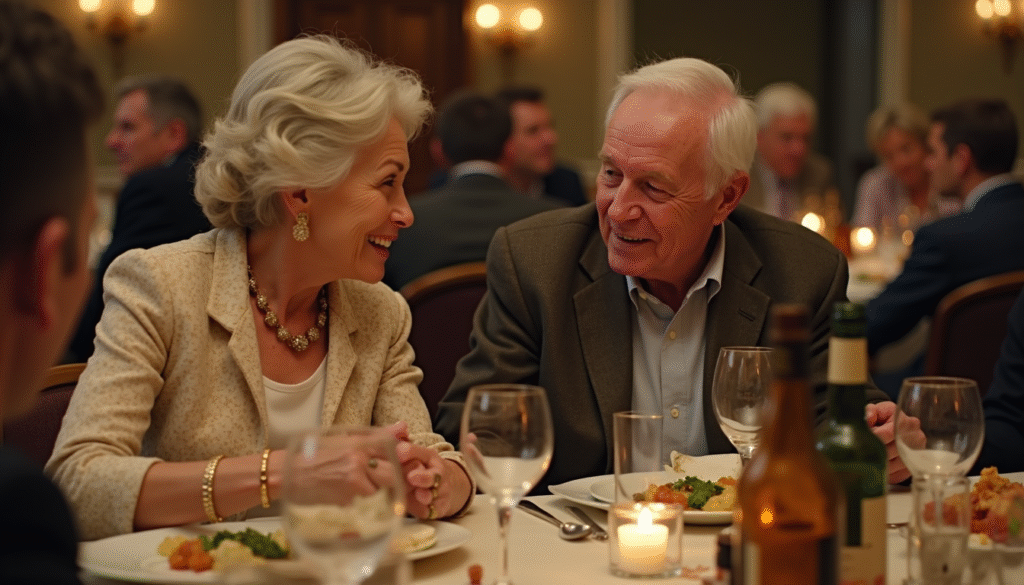At a crowded dinner party, two people sit at opposite ends of the table. They don’t exchange many words across the chatter and clinking glasses, but every so often one looks up. A glance—barely a second long—crosses the room. The other catches it, nods almost imperceptibly, and returns to conversation. Nothing more is said, yet everything is understood.
This is the strange, tender language of long-married couples. A lexicon written not in ink, but in decades of living side by side. It is built in kitchens at midnight, in waiting rooms at hospitals, in grocery aisles and shared taxis, in mornings that begin with the same old rituals. It’s a language invisible to the outside world, but unmistakable to those who speak it. Over time, marriages acquire a silent vocabulary—tiny gestures, subtle sounds, fleeting touches—that carry more weight than any string of words.
The Vocabulary of Glances
Eyes are the oldest messengers. In a long marriage, they become finely tuned instruments capable of delivering paragraphs in a flicker. A raised eyebrow might mean, We’ve had this conversation before, don’t start again. A quick widening might say, Did you hear that? Then there’s the playful narrowing that signals, You’re about to get teased later.
In social spaces, this silent vocabulary often does the heavy lifting. One look across a crowded room can mean, We should leave soon, I’m tired. Another can mean, Go on, stay a while longer, I know you’re enjoying yourself. These messages pass invisibly between them, leaving others none the wiser.
Glances also serve as lifelines. In awkward conversations, one person’s eyes seek the other’s—sometimes to ask for rescue, sometimes to share the absurdity of what’s unfolding. There is comfort in knowing that without a single word, someone else sees the same thing you do, feels the same undercurrent, reads the room in the same shade. It is solidarity, expressed in a fraction of a second.
The Grammar of Touch
Words may stumble, but touch speaks clearly. In long marriages, touch evolves into grammar—an intricate system of pauses, emphasis, and exclamations. A hand placed gently at the small of the back says, I’m here, you’re safe. Fingers brushing across the table mean, I noticed, and I care. A squeeze of the shoulder during a stressful moment carries the force of whole paragraphs of reassurance.
Unlike grand romantic gestures, these are quiet, almost invisible signals. They don’t call attention to themselves. They simply anchor the bond. The couple walking side by side doesn’t need to hold hands the entire time; sometimes just the grazing of knuckles is enough. The weight of a palm on a knee during a tense silence can dissolve an argument before it takes shape.
Over years, touch becomes less about passion and more about presence. It is less about fireworks, more about warmth. Yet in its simplicity lies a depth that can only be built by repetition and memory: countless nights of sitting together, countless mornings of shared routines, countless small reminders that bodies, too, can carry love without needing to announce it.
The Punctuation of Sighs and Silences
Couples learn to punctuate life not just with words, but with the spaces between them. A sigh, depending on its texture, might mean, Here we go again, or I’m tired but happy, or I understand you. To an outsider, all sighs sound alike. To the person who has lived with you for decades, each one has a distinct timbre.
Silence, too, changes character in a long marriage. Early on, silence may feel heavy, even awkward, demanding to be filled. But over years, it softens. Two people can sit in the same room, one reading a newspaper and the other making tea, and the quiet hum of domestic life becomes a comfort. Nothing is said, but everything is felt.
There are silences of companionship—when two people walk together without talking, simply sharing the rhythm of footsteps. There are silences of care—when one waits for the other to find words, not rushing the moment. And there are silences of grief—when nothing can be said, but presence itself becomes the language. In every case, these pauses are full, not empty. They are punctuation marks in the ongoing story, shaping meaning without spelling it out.
The Shared Dictionary of Daily Life
Every long marriage carries a private dictionary—an accumulation of inside jokes, shorthand phrases, and shared references. A single word may recall an entire incident from ten years ago. A look at an object—a chipped mug, an old sweater—can spark laughter or tenderness because of the memories attached.
Rituals add to this dictionary. The way tea is made in the morning. The particular side of the bed each person claims. The quiet coordination of folding laundry or cooking a meal together. These routines, invisible to outsiders, form a rhythm that gives shape to the marriage.
Even disagreements develop their own familiar scripts. Certain phrases signal the start of a recurring debate, and certain gestures indicate the truce that follows. Over time, couples come to know the choreography of conflict as well as that of harmony. And in this knowledge lies comfort: even quarrels become another form of intimacy, proof of continued engagement.
This shared lexicon also makes space for humor. The jokes no one else would find funny, the words deliberately mispronounced, the songs sung off-key just to provoke a groan. These are threads in the tapestry of a marriage, stitched quietly, day after day.
The Beauty of Being Seen
Beneath all these signals—glances, touches, sighs, rituals—lies a single truth: to be seen. Long marriages are not free of friction, nor are they endlessly romantic. But they offer a kind of intimacy that goes beyond affection. They offer recognition.
To be known so thoroughly that one’s smallest gestures are legible is both humbling and liberating. You are no longer a mystery, nor do you need to perform. The sigh, the nod, the weary glance, the quiet laugh—they are all understood without translation. And this understanding itself becomes the deepest form of love.
It is not about finishing each other’s sentences, though that sometimes happens. It is about not needing to start the sentence at all. It is about living in such close orbit that presence itself becomes eloquent.
Conclusion
Return to the dinner party: the couple sitting across the table, speaking little, exchanging glances. To others, they may seem distant, detached even. But beneath the surface, an entire novel is unfolding—paragraphs written in the language of eyes, punctuation marks in sighs, metaphors in the touch of a hand.
This language has no dictionary, no grammar textbook, no translator. It cannot be taught; it can only be built. It is composed slowly, across years of shared life—years of laughter, quarrels, routines, and surprises. And in its simplicity, it reveals something profound: that love, in its truest form, does not always need words. Sometimes, to be understood without speaking is the greatest intimacy of all.



